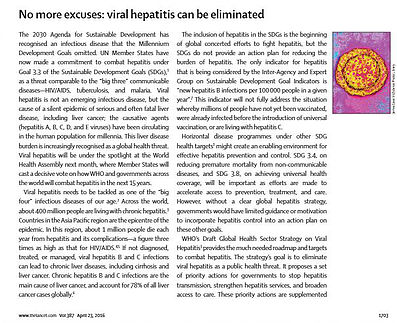No More Excuses: Viral Hepatitis Can Be Eliminated

Comment in Lancet
The 2030 Agenda for Sustainable Development has recognised an infectious disease that the Millennium Development Goals omitted. UN Member States have now made a commitment to combat hepatitis under Goal 3.3 of the Sustainable Development Goals (SDGs),1 as a threat comparable to the “big three” communicable diseases—HIV/AIDS, tuberculosis, and malaria. Viral hepatitis is not an emerging infectious disease, but the cause of a silent epidemic of serious and often fatal liver disease, including liver cancer; the causative agents (hepatitis A, B, C, D, and E viruses) have been circulating in the human population for millennia. This liver disease burden is increasingly recognised as a global health threat. Viral hepatitis will be under the spotlight at the World Health Assembly next month, where Member States will cast a decisive vote on how WHO and governments across the world will combat hepatitis in the next 15 years.
Viral hepatitis needs to be tackled as one of the “big four” infectious diseases of our age.2 Across the world, about 400 million people are living with chronic hepatitis.3 Countries in the Asia Pacific region are the epicentre of the epidemic. In this region, about 1 million people die each year from hepatitis and its complications—a figure three times as high as that for HIV/AIDS.4,5 If not diagnosed, treated, or managed, viral hepatitis B and C infections can lead to chronic liver diseases, including cirrhosis and liver cancer. Chronic hepatitis B and C infections are the main cause of liver cancer, and account for 78% of all liver cancer cases globally.
